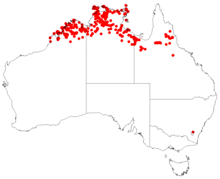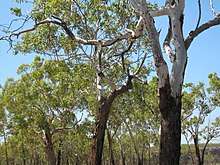Eucalyptus miniata
| Darwin woollybutt | |
|---|---|
.jpg) | |
| E. miniata flowers | |
| Scientific classification | |
| Kingdom: | Plantae |
| Clade: | Angiosperms |
| Clade: | Eudicots |
| Clade: | Rosids |
| Order: | Myrtales |
| Family: | Myrtaceae |
| Genus: | Eucalyptus |
| Species: | E. miniata |
| Binomial name | |
| Eucalyptus miniata | |
 | |
| Occurrence data from AVH | |

_(20165942804).jpg)
Eucalyptus miniata, commonly known as the Darwin woollybutt[1]',[2][3] is a eucalypt which is native to northern Australia.[2]
Description
The medium-sized tree which typically grow to 15 to 25 metres (49 to 82 ft) in height but can be as tall as 30 m (98 ft). The tree will mostly have a single trunk forming from a lignotuber.[1]
The bark is soft, rough, fibrous and fissured, grey to red-yellow-brown in colour[4] over the trunk with white to pale grey smooth bark on the upper trunk and branches.[1] The greenish-brown juvenile leaves are 3 to 6 centimetres (1.2 to 2.4 in) long and 2 to 3 cm (0.79 to 1.18 in) wide and elliptic in shape, while adult leaves are 7.5 to 15 cm (3.0 to 5.9 in) in length with a width of 2.5 to 5 cm (0.98 to 1.97 in) with a lanceolate or falcate shape.[4] The adult leaves are arranged alternately and are discolorous, dull to slightly glossy green with a rounded base that tapers to the petiole. Petioles are 1.2 to 2.7 cm (0.47 to 1.06 in) long.[1]
Flowering occurs from May to September and produces inflorescences with orange or scarlet flowers are up to 3.5 cm (1.38 in) in diameter.[4] Each simple axillary inflorescence has seven flowers per umbel. The glaucous buds have a clavate to rarely broadly fusiform shape and are 1 to 2.3 cm (0.39 to 0.91 in) long and 0.9 to 1.2 cm (0.35 to 0.47 in) wide with the calyx fused to the corolla. It later forms fruit that have a cylindrical to barrel-shaped to urceolate shape and have longitudinal ribbing and are 3.3 to 6 cm (1.30 to 2.36 in) in length. The fruits contain dark grey to black seeds that are 5 to 7 mm (0.20 to 0.28 in) in length with an obliquely pyramidal to flattened cuboid shape.[1]
Red-tailed black cockatoos living in the north of Australia prefer feeding on the Darwin woollybutt.[4]
Habitat
E. miniata is commonly found in open forest and savanna communities in sandy soils. It is also found on sandstone escarpments.[2]
Distribution
It is found in the following bioregions: Arnhem Coast, Arnhem Plateau, Central Kimberley, Daly Basin, Darwin Coastal, Einasleigh Uplands, Gulf Coastal, Gulf Fall and Uplands, Gulf Plains, Northern Kimberley, Ord Victoria Plain, Pine Creek, Tiwi Cobourg, and Victoria Bonaparte.[2]
Taxonomy and naming
The species was first formally described by the botanist Johannes Conrad Schauer in 1843 in Wilhelm Gerhard Walpers work Repertorium Botanices Systematicae.[5] The only synonym is Eucalyptus aurantiaca described by Ferdinand von Mueller in 1859 in the work Monograph of the Eucalypti of tropical Australia published in the Journal of the Proceedings of the Linnean Society, Botany.[6] The species name miniata is latin meaning flame-scarlet referring to the colour of the filaments of the flowers.[1] The Miriwoong people of the Kimberley call the tree, woolewoorrng.[7]
Distribution
E. miniata is native to Australia's Top End, found from Cape York in north Queensland across through to the Northern Territory into the Kimberley Region of northern Western Australia.[4] The tree is mostly found in open woodland communities, growing in deep sandy soils on or around sandstone[1] or quartzite escarpments or on the surrounding plains[3]
See also
References
- 1 2 3 4 5 6 7 "Eucalyptus miniata". Euclid. CSIRO. Retrieved 13 December 2017.
- 1 2 3 4 NT Flora Northern Territory Flora online Eucalyptus miniata factsheet. Retrieved 11 June 2018
- 1 2 "Eucalyptus miniata". FloraBase. Western Australian Government Department of Parks and Wildlife.
- 1 2 3 4 5 Elliot, Rodger W.; Jones, David L.; Blake, Trevor (1992). Encyclopaedia of Australian Plants Suitable for Cultivation: Vol. 4: Eu-Go. Port Melbourne: Lothian Press. p. 148. ISBN 0-85091-213-X.
- ↑ Schauer, J.C. in Walpers, W.G. (1843), Repertorium Botanices Systematicae 2(5): 925. Retrieved 7 July 2018.
- ↑ "Eucalyptus miniata A.Cunn. ex Schauer". Atlas of Living Australia. Global Biodiversity Information Facility. Retrieved 13 December 2017.
- ↑ Mirima Dawang Woorlab-gerring Language and Culture Centre. (2017) Miriwoong Woorlang Yawoorroonga-woorr - a Miriwoong Lexicon for all. Kununurra, Western Australia.